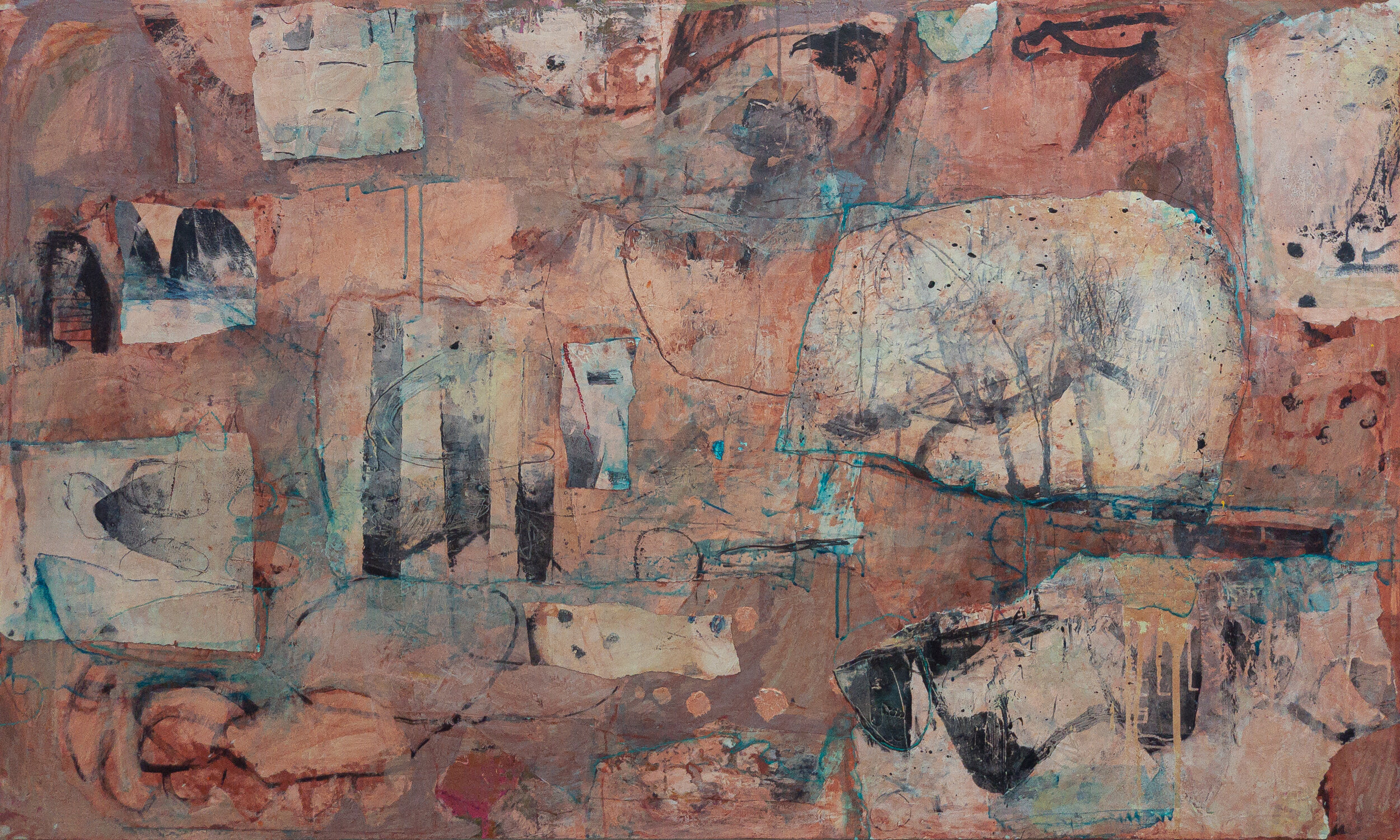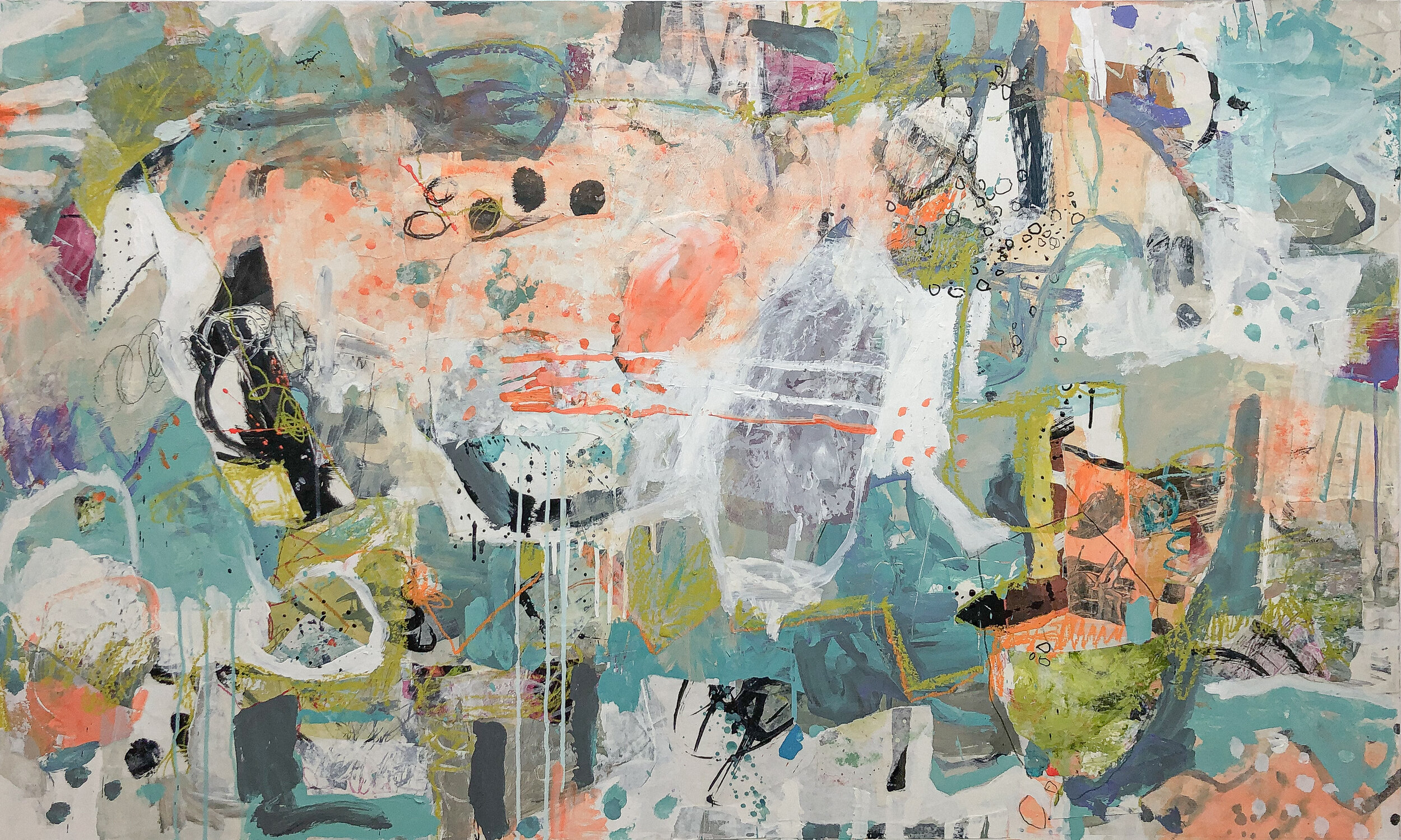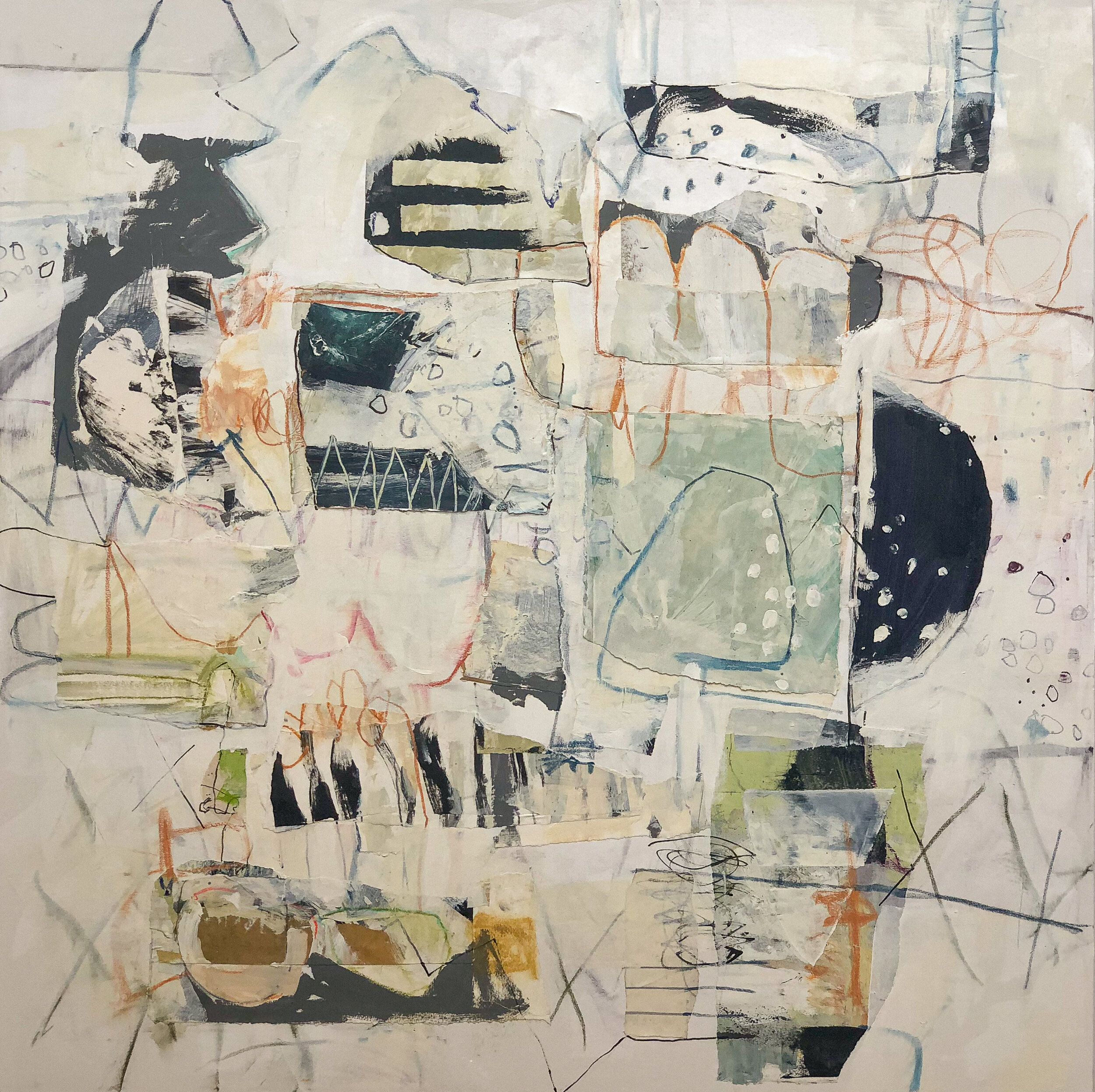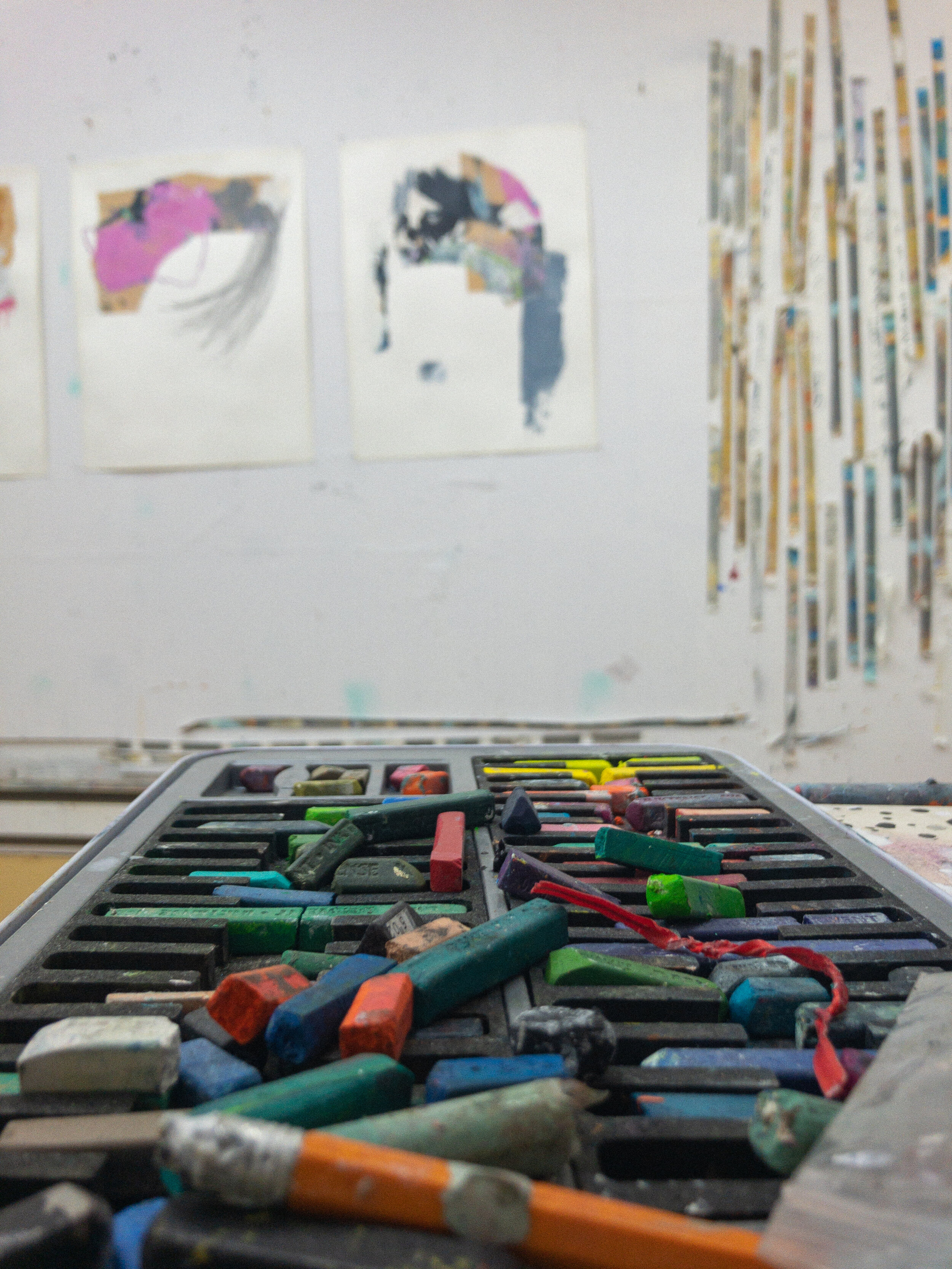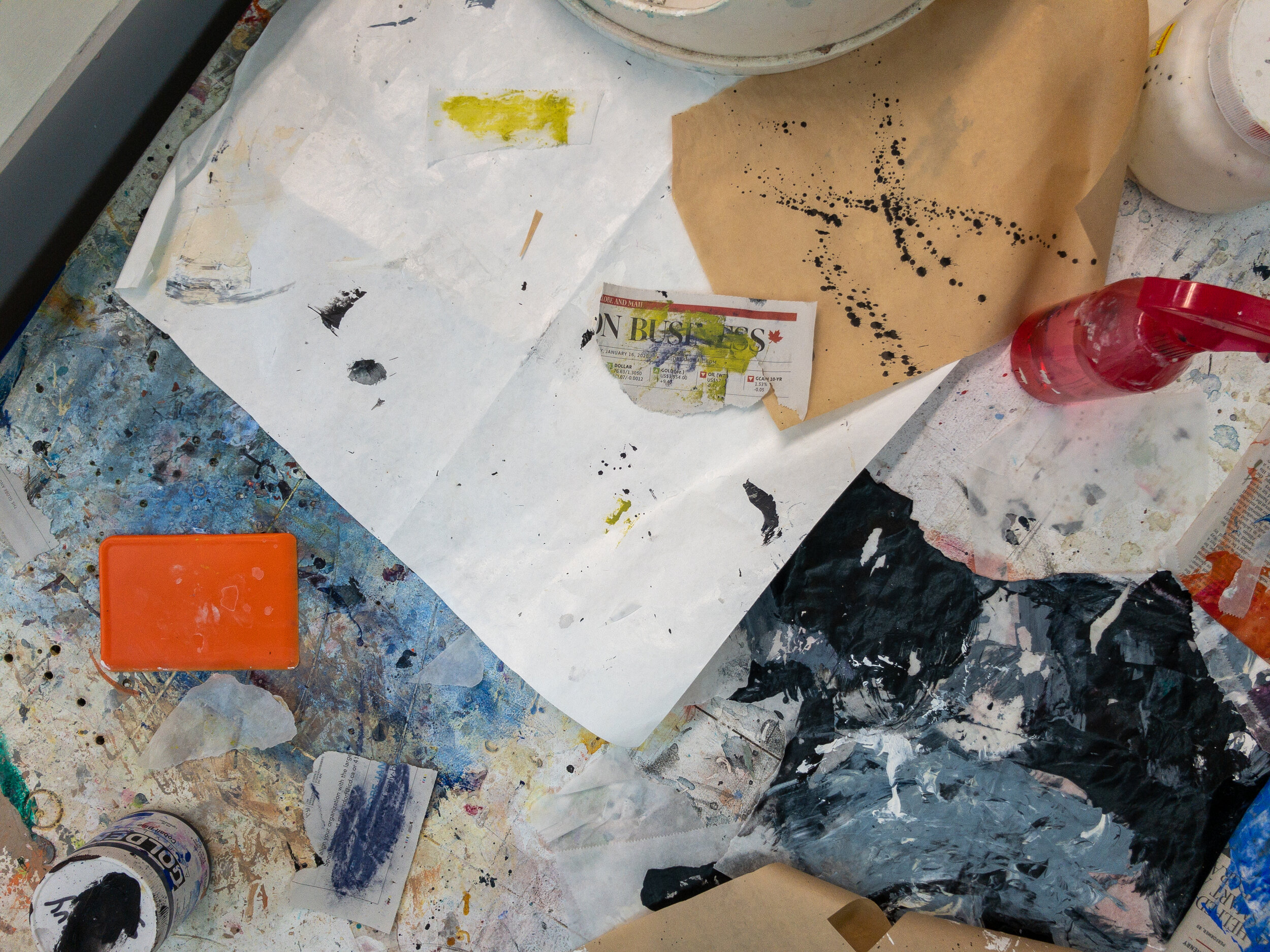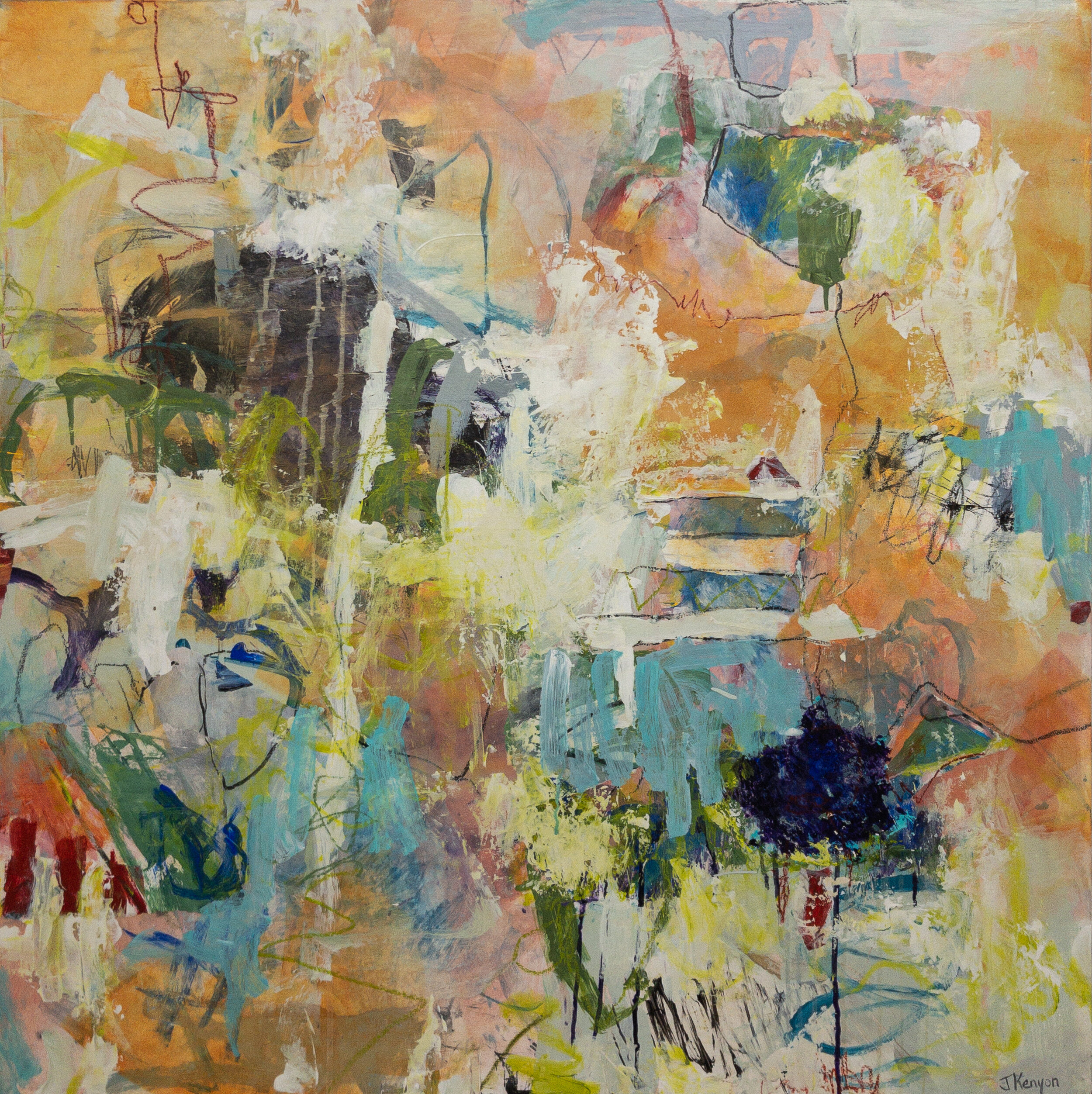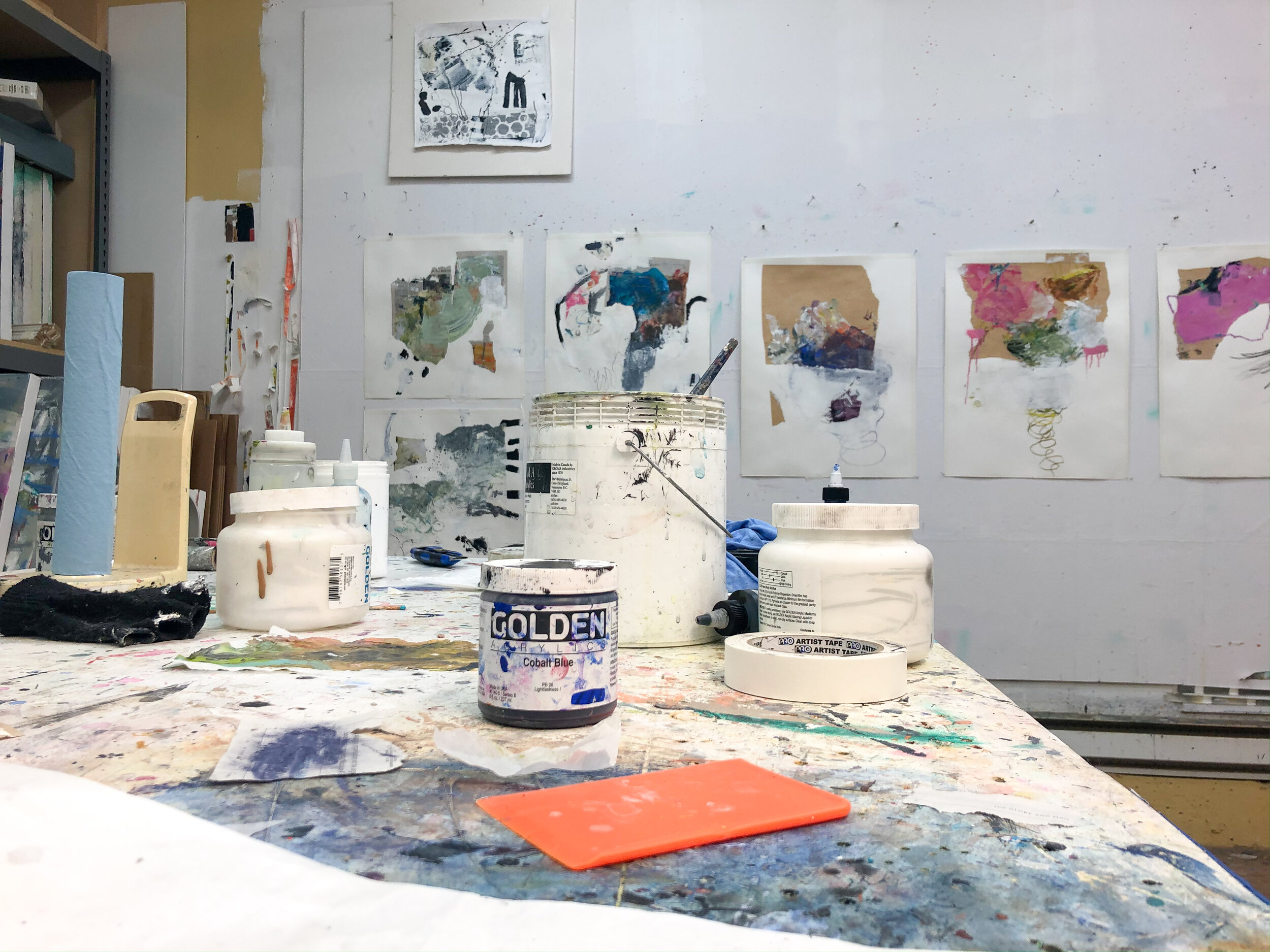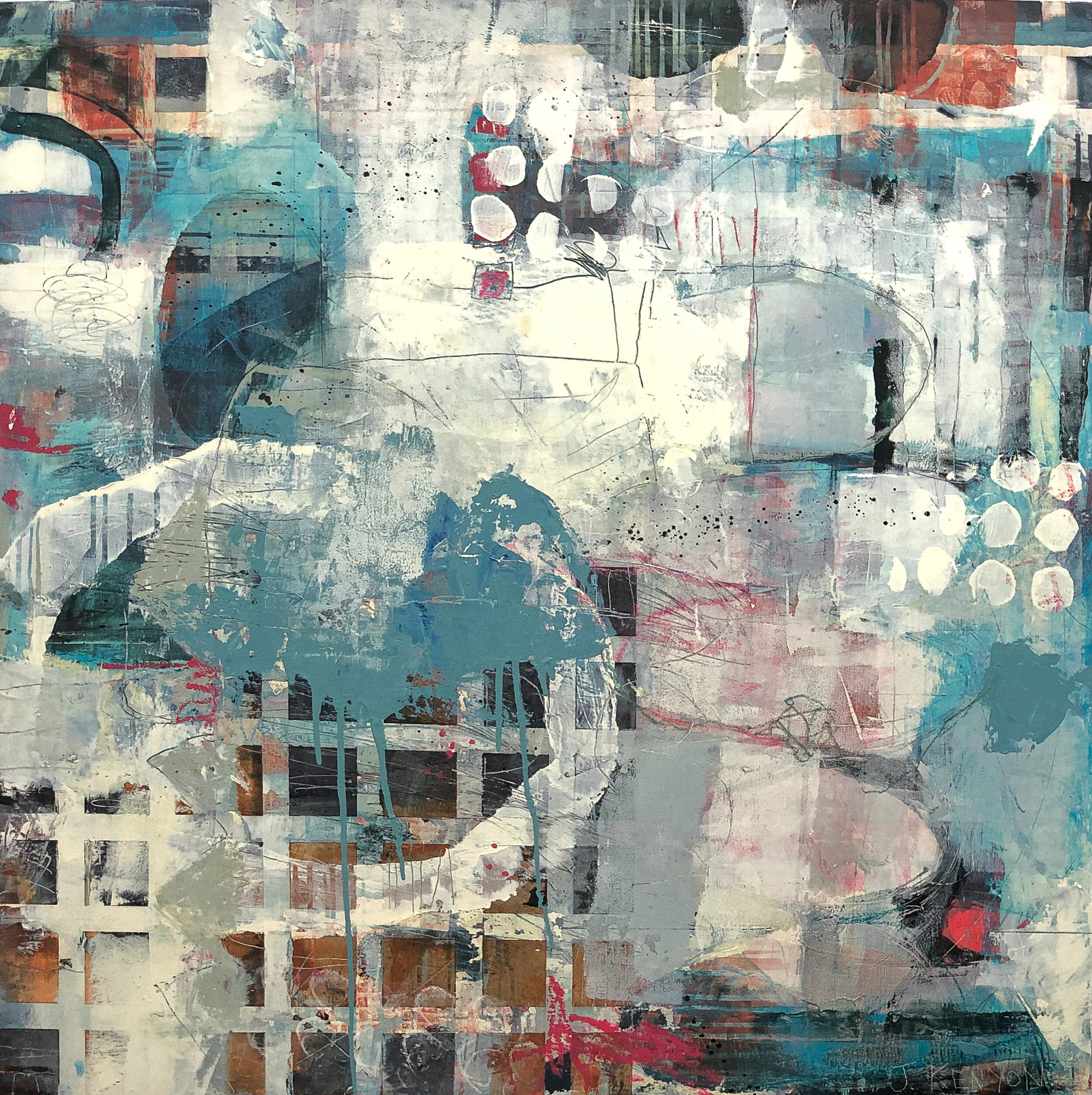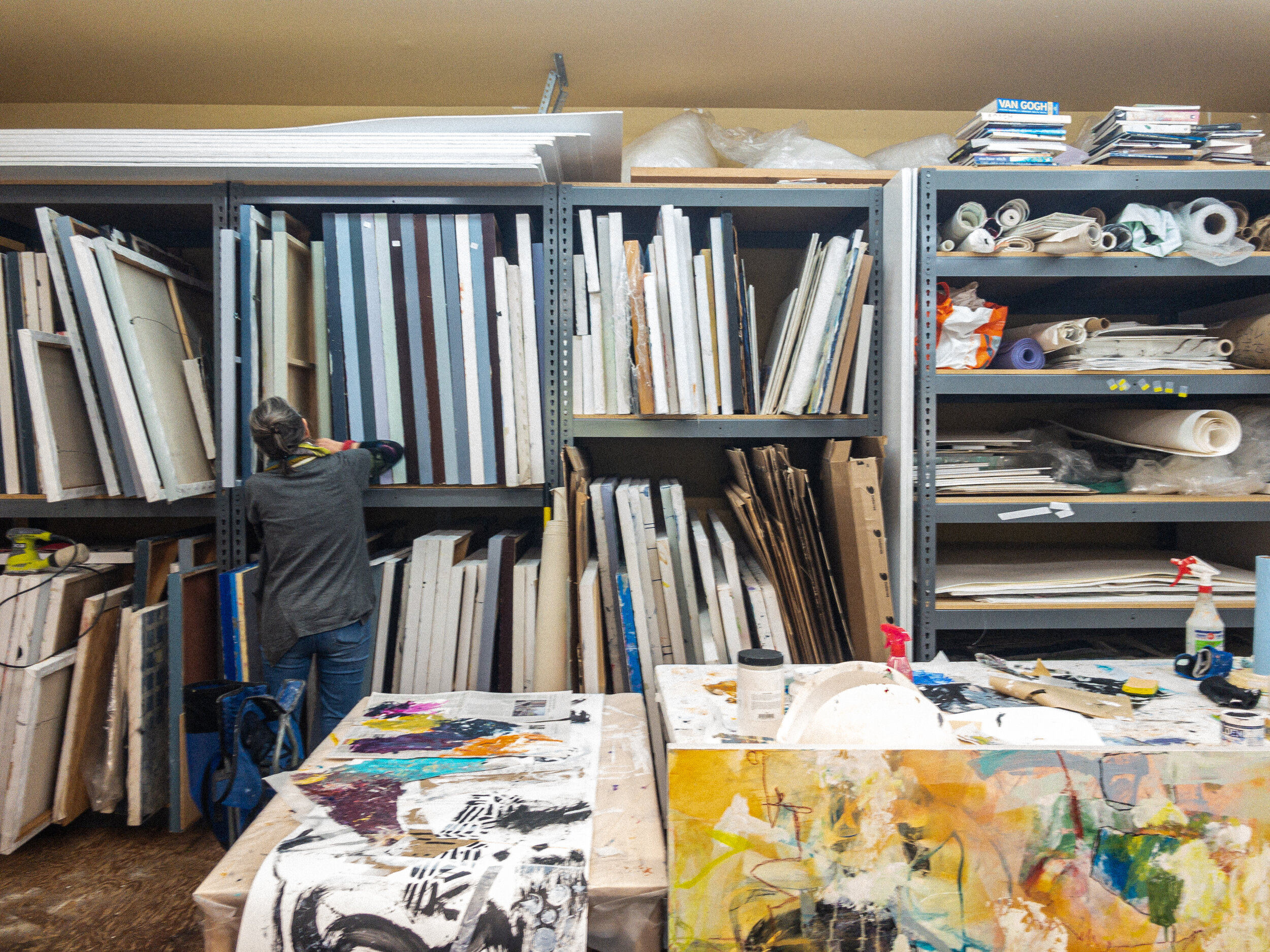Tête-à-Tête: Jane Kenyon
The amazing journey of why a doctor left the world of medicine to follow her passion.
About Jane
Jane Kenyon was born in Canada in 1953 and currently works in her home studio in North Vancouver BC. She began her working life as a medical doctor but had always been drawn to a career in visual art. In 1993, Kenyon began to study and work as an artist full-time.
Her early artistic life was as a fibre artist, with most of her art career spent in contemporary embroidery. Searching for a more intuitive and immediate form of personal expression, Kenyon turned to non-objective painting about 8 years ago. Recently, she has been exploring how paint and embroidery can coexist to create meaning.
Kenyon’s art, including fibre art and works on canvas and paper, has been widely shown and collected. She has exhibited and won awards in Canada, USA, Europe and South Korea.
Arriving at Jane Kenyon’s, your eyes will immediately be drawn to different art pieces: textured wall art, paintings, custom chairs. Each piece, exuding colour and life. She welcomed us and led us through to a seating area in her backyard oasis. It is such a pleasure to be able to feature Jane Kenyon as our first Seasoned Woman to grace the pages of SW. Her story is very inspiring and may be helpful to other women who have their “Inner Artist” beckoning to have a voice.
Interview with Jane Kenyon
SW - It is such a pleasure to be able to feature you as our first Seasoned Woman to grace the pages of SW. Your story is very inspiring and I want to be able to share this with other women who may have their “Inner Artist” beckoning to have a voice. Tell me, when did you first know the you had a passion for art?
SW: I have always been fascinated with your transition from medical doctor to professional artist. How do you like to be introduced to people? Doctor turned artist? Artist?
JK: I like to be known as Jane Kenyon, Artist. (chuckle) I only use Dr. Kenyon when I need to - when I’m calling a doctor or the hospital, needing medical assistance for my self or my family.
SW: Tell me a bit about your journey. I remember meeting you when you just moved to Bowen Island over 20 years ago when you were becoming a professional artist.
JK: I went through many transitions. When I finished my degree, I went away - I interned in the States, did some locums and I travelled. I was away for about a year and a half then settled back into Saskatoon. I joined a medical practice with three men - I was the only female. A couple of them had been in the practice for quite a few years at that time. Let’s see, I practiced full time for about 10 - 11 years, part time for a couple of years after that - full time is double time and part time is full time (chuckle), at least that’s how it was for our practice.
SW: When/how did your passion for creating art begin?
JK: When I really became consciously aware of it, I was in my mid-thirties – before that, I was emotionally afraid of it. In high school and university – art scared me – the thought of being an artist really scared me. I thought you had to be born to be an artist – born with the gift, the talent. I wasn’t, so I couldn't even think about it - I knew inside it was something I passionately wanted but thought it wasn’t even a possibility so it was off the table. I remember moving to a high school in Grade 12 and it had a big art program. I would take a longer route going from class to class so I wouldn’t have to walk by the art classroom – I was intimidated by the artists – I felt too envious – they had something I didn’t have – they were different. A very strong voice kept telling me that I could never be like them – they were the ‘other’. Fast forward to my mid-thirties and I started to think, okay, it doesn’t matter if I suck - I had a successful medical practice - I had confidence, so I could play with it – if I was really bad it didn't matter. Well, it was more fun than I thought. Having this other ‘thing’ (my practice) that I was good at made it okay. It opened this whole new world. I had always made things - fibre was in my bones - my grandmothers, my mother - it was women’s stuff - I always knit, embroidered - that was normal, then I added weaving - more creative I thought. I’d always been doing things - but painting opened this new magical world. I thought painting was the pinnacle of being an artist.
SW: How did you begin to develop your art?
JK: I signed up at a local art gallery for a water colour class, it was a little community class 4 to 5 weeks - it was awful! We were told what to bring. I bought all this stuff, I didn’t even know water colours came in tubes. She set up a still life and she told us to paint it. I had to look around the room to see what everyone else was doing. I somehow believed that wasn’t the right class for me. I didn’t however, lose my passion, albeit that class could have completely deflated my balloon. Then I discovered acrylics – a whole new world! My advice to anyone is “don't start with watercolours” . They’re the hardest - they behave differently – just because you're good at one doesn't mean you’ll be good at every medium. I started painting on my own in my spare time. Eventually, I began working part time - I stopped being ‘on call’ and just worked in the clinic with a regular schedule so I signed up for more classes, workshops and I read a lot about art.
SW: What gets you up in the morning? What motivates you?
JK: Constant challenge - if it gets easy, I need to make it harder - a challenge that’s successful enough of the time to keep me wanting to try more - I’m easily bored and if it gets easy, I need to create a new challenge. I am really a researcher - I like to try things. I ask myself “What if I do this and this together?”. I think that creativity is wondering “What if?”. For me that’s the definition of creativity.
SW: When do you feel that you’ve finished a piece?
JK: I see my work as a conversation - an active process - I listen to something inside that tells me “Try this.” so I do and then I might try something else. Sometimes I think it might be finished but then in the morning I keep working on it.
“Creativity is wondering “What if?”. For me that’s the definition of creativity.”
SW: Do you see any similarities to medicine?
JK: I’ve thought about this a lot over the years - mostly my answer is ‘no’, however looking for answers seems to be a common thread for me in art and medicine. I love research - searching for answers to a complex problem. It was really hard for me to access my right brain in the beginning. After all, I was trained as a scientist. You’re taught ‘facts only’. The doctors who are the best are those who can take all the facts and make sense of them with creative thinking - that's how I see the similarities. There’s a lot of creative thinking in the medical world. Just because something worked in the past doesn’t necessarily mean that it will work now - it may not be the best answer. COVID-19 is now teaching us this now - everything is changing - what works now may not work later - a good example is penicillin - it worked wonders in the past but now… One of the reasons I don't feel panicky about the current COVID-19 pandemic is because I believe in the scientists who will find answers.
SW: When did you decide “This will be my profession.”
JK: It’s hard to remember - it was a mixed up time. I had little kids - toddlers, pre-schoolers, I was taking classes. It was becoming more and more challenging for me. I was so stressed by work at the clinic - I was (undiagnosed) clinically depressed. I think I decided that I was way more passionate about art than medicine. I started saying I was becoming an artist. I needed something to justify why I was quitting medicine - I needed an identity – to tell myself and others. It was a horrible time for me.
SW: What was the catalyst for taking the leap to quit your medical practice?
JK: I was completely stressed - the pressure was immense. I became quite internally dysfunctional - I was still able to do my job but I would then go home with my patient charts and make a list of who I needed to call in the morning - I was compelled to check on them even though I gave them thorough, detailed instructions before they left the clinic. For example - if someone came in with a sore throat & swollen glands, I would need to call them in the morning to make sure they didn’t have leukaemia. Nobody knew that but me and my therapist - I was doing my job well enough but I knew I was headed for something serious.
SW: Where do you get your inspiration now?
JK: Other artists - Joan Mitchell, Cy Twombly - my two top inspirations from the past. An art form I really love is minimalism - I would love to express myself with minimalism but just can’t - people who can express so much with so little inspire me - abstract is hard anyway but minimalism with abstract is really hard.
SW: You started with fibre arts - and where did you go from there?
JK: I moved from weaving to stitching - I started painting at around the same time - going back and forth. I did landscapes - contemporary embroidery. Fibre art feels very natural to me. I’ve been painting abstractly for the past 8 years. There is no objective - just whatever is flowing out of my body. I’m in a research stage right now, I’m adding stitch back into my work. My new challenge is “Does stitch have a place in my work? Is there a way that stitch and paint can work well together?” I’m still not sure - it’s been fun to go back to stitching - I do miss painting - I’m not doing as much as I used to.
SW: What colours do you prefer to work with?
JK: I use whatever colour I feel like using - I admire neutral palettes even though I’m not very good at them.
SW: Do you change colours with the season?
JK: Nope - they might change five times in a week.
SW: Our world is going through significant change right now. How has COVID-19 affected your work?
JK: Only in that I’m now doing more work - I have no other responsibilities - I don’t listen to a lot of news - I find it very stressful - it’s not good for my mental health.
SW: Racial injustice is now being given a global stage - an issue that has been too long in the background. How are you navigating this?
JK: I don’t think it’s going to affect my work in a direct way, although it’s certainly a tremendous awareness for me - more than COVID. The state of the world and racism is constantly on my mind - it’s a feeling of helplessness. I don’t know that world events affect my work. I find I can only tolerate so much because I feel so helpless and discouraged - I need to filter.
SW: What would you like people to know about you that they don’t really know?
JK: I want people to think of me as an artist - somebody who creates meaning in the world through her art. I’m an introvert and that’s okay.
SW: Tell me about travel - does it impact your work?
JK: Oh yes, I have travelled a fair bit. Not only does it impact my creativity but it inspires me. In particular, Mexico - the colour, the fibre and the culture – it’s amazing. Costa Rica – the beauty of Nature. I was doing landscape when I travelled there and it was very inspiring.
SW: Where would you like to go next?
JK: Travel gives me the break - even if it’s not for my work - it’s so completely different - it’s a way for me to unwind. I usually work 7 days a week - sometimes I take a day where I don't work at all. So travel nourishes me. I was planning on going to Paris (again) and Spain. I would like to go back to Mexico – Oaxaca, Pueblo, and San Miguel.
SW: If you were to mentor younger women - Millennials and Gen Z’s, what would you say to them today?
JK: Find something that makes you happy and do it! If you hate your job, quit, listen to that voice inside and follow it - seek therapy, early and often. If you’ve spent the past 15 years studying hard and making partner in a firm, and you hate it, listen to your heart and when you can, take the leap. You may not be able to do it right away, but plan for it.
SW: What about selling your work? I often hear that artists find it quite challenging.
JK: I would love to sell more of my work, however I’m not willing to put the effort into marketing - I would rather create.
SW: You have quite a large following on Instagram - over 36k. How did you attract this many Followers?
JK: Post everyday - have a minimum of 30 relevant hashtags. Visuals are key, check how they look on screen, the contrast, the colour - are they dramatic. When you get a lot of ‘likes’, the algorithm pushes you up. Comment on other’s work - follow people who inspire you. Let them know they are inspiring to you. Don’t judge yourself against others who are posting…remember that they are curating and showing only their best work, you don’t see all their mistakes and failures.
SW: What is the price range of your original art pieces?
JK: It’s quite a large price range - $200 for a piece on paper (16x16) to $4,000 on a large stretch canvas (48x60). I have some pieces listed with saatchiart.com. I used to accept commissions but no longer do as it’s too structured for me.
SW: Is it hard to let go when you sell a piece?
JK: No, when someone buys my art, it becomes theirs.
Our wine glasses nearing empty, Jane and I chatted a while more, pondering life paths and following intuition. She is an incredible inspiration to Seasoned Women and we can’t wait to see what she creates next!

